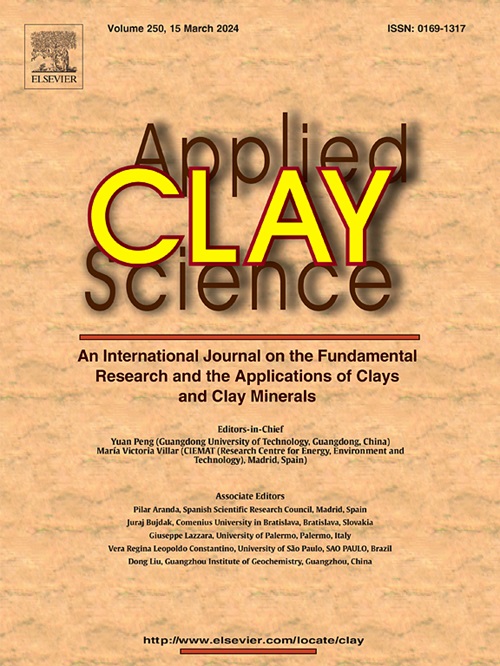用表面电荷法表征蛇纹石碳矿化反应性
IF 5.8
2区 地球科学
Q2 CHEMISTRY, PHYSICAL
引用次数: 0
摘要
辉长石、蜥蜴石和温石棉是蛇纹石矿物,在涉及超镁质岩石和尾矿的碳矿化过程中,它们是Mg2+的供体。这些矿物的反应性是通过在适当的时间和条件下碳矿化技术可以浸出的Mg2+总量来测量的。在环境条件下考察了它们的溶解过程,以阐明Mg2+释放的来源和机制。本文报告了溶解实验和zeta电位测量的结果。在浸出之前,所有三种蛇纹石多晶在pH约为11.9或更高时均表现出高碱性IEPs,这与它们的高Mg2+与Si4+比率(即Mg/Si比)相关。随着溶解的进行,zeta电位值和Mg/Si比值均下降,反映了蛇纹石的非化学计量溶解,并突出了多态性特异性变化。浸出后的IEP测量表明,表面变化的程度与zeta电位的变化密切相关。建立了碳矿化反应性的递增顺序:反长花岗岩;利蛇纹石& lt;非石棉温石棉<;asbestiform温石棉。在多晶态中,释放Mg2+最少的反长花岗岩表现出最显著的zeta电位降低,并在pH 5左右向酸性IEP转变。相比之下,石棉型温石棉的Mg2+释放量最高,在pH值9附近保持碱性IEP时,zeta电位还原较低。非石棉温石棉对Mg2+的浸出较少,zeta电位降低适中。其次是lizardite,它释放的Mg2+更少,在pH值11左右保持碱性IEP,并且表现出均匀的溶解,只有轻微的zeta电位下降。这些观察结果表明,蛇纹石的早期Mg2+浸出主要是一个表面过程,显著影响矿物的电动力学行为。较高的Mg2+释放与溶解度的增加无关,因为Mg2+离子不是由整体溶解产生的。Mg2+浸出与zeta电位净变化之间缺乏1:1的关系,这强调了蛇纹石多晶中不同的电动力学和表面溶解行为。zeta电位分析结果为研究超镁铁质型碳矿化过程中蛇纹石矿物的反应性贡献提供了有价值的见解。本文章由计算机程序翻译,如有差异,请以英文原文为准。
A surface charge approach to characterize serpentine reactivity for carbon mineralization
Antigorite, lizardite and chrysotile are serpentine minerals that act as Mg2+ donors during carbon mineralization involving ultramafic rocks and tailings. The reactivity of these minerals is measured by the total amount of Mg2+ that can be leached under appropriate time and conditions for the proposed carbon mineralization technology. Their dissolution processes were examined under ambient conditions to elucidate the sources and mechanisms of Mg2+ release. Results from dissolution experiments and zeta potential measurements are reported here. Prior to leaching, all three serpentine polymorphs exhibited highly alkaline IEPs at approximately pH 11.9 and higher, which correlated with their high Mg2+ to Si4+ ratios (i.e., Mg/Si ratio). As dissolution proceeded, a decrease in both zeta potential values and Mg/Si ratio was observed, reflecting the non-stoichiometric dissolution of the serpentines and highlighting polymorph-specific variations. Post-leaching IEP measurements revealed that the degree of surface alteration is closely linked to changes in zeta potential. The following order of increasing carbon mineralization reactivity is established: antigorite < lizardite < non-asbestiform chrysotile < asbestiform chrysotile. Among the polymorphs, antigorite, which released the least Mg2+, showed the most significant reduction in zeta potential and a shift to an acidic IEP around pH 5. In contrast, asbestiform chrysotile, with the highest Mg2+ release, exhibited lower zeta potential reduction while maintaining an alkaline IEP near pH 9. Non-asbestiform chrysotile leached less Mg2+ and showed moderate zeta potential reduction. This is followed by lizardite, which released even less Mg2+, retained an alkaline IEP around pH 11 and demonstrated uniform dissolution with only a slight decrease in zeta potential. These observations suggest that early-stage Mg2+ leaching from serpentine is predominantly a surface process that significantly influences the electrokinetic behaviour of the minerals. Higher Mg2+ release does not correlate with increased solubility, as the Mg2+ ions are not derived from bulk dissolution. The lack of a 1:1 relationship between Mg2+ leaching and net change in zeta potential emphasizes the distinct electrokinetic and surface dissolution behaviours among serpentine polymorphs. The findings from zeta potential analysis offer valuable insights into the reactivity contribution of serpentine minerals during carbon mineralization involving ultramafic-type feedstocks.
求助全文
通过发布文献求助,成功后即可免费获取论文全文。
去求助
来源期刊

Applied Clay Science
地学-矿物学
CiteScore
10.30
自引率
10.70%
发文量
289
审稿时长
39 days
期刊介绍:
Applied Clay Science aims to be an international journal attracting high quality scientific papers on clays and clay minerals, including research papers, reviews, and technical notes. The journal covers typical subjects of Fundamental and Applied Clay Science such as:
• Synthesis and purification
• Structural, crystallographic and mineralogical properties of clays and clay minerals
• Thermal properties of clays and clay minerals
• Physico-chemical properties including i) surface and interface properties; ii) thermodynamic properties; iii) mechanical properties
• Interaction with water, with polar and apolar molecules
• Colloidal properties and rheology
• Adsorption, Intercalation, Ionic exchange
• Genesis and deposits of clay minerals
• Geology and geochemistry of clays
• Modification of clays and clay minerals properties by thermal and physical treatments
• Modification by chemical treatments with organic and inorganic molecules(organoclays, pillared clays)
• Modification by biological microorganisms. etc...
 求助内容:
求助内容: 应助结果提醒方式:
应助结果提醒方式:


